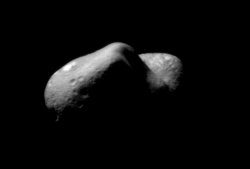433 Eros
|
|
| Discovery A (http://cfa-www.harvard.edu/iau/lists/NumberedMPs.html) | |
|---|---|
| Discoverer | Carl Gustav Witt |
| Discovery date | August 13, 1898 |
| Alternate designations | 1898 DQ; 1956 PC B (http://cfa-www.harvard.edu/iau/MPDes.html) |
| Category | Near-Earth, Mars-crosser asteroid |
| Orbital elements C (http://asteroid.lowell.edu/) Epoch October 22, 2004 (JD 2453300.5) | |
| Eccentricity (e) | 0.223 |
| Semi-major axis (a) | 218.155 Gm (1.458 AU) |
| Perihelion (q) | 169.548 Gm (1.133 AU) |
| Aphelion (Q) | 266.762 Gm (1.783 AU) |
| Orbital period (P) | 643.219 d (1.76 a) |
| Mean orbital speed | 24.36 km/s |
| Inclination (i) | 10.829° |
| Longitude of the ascending node (Ω) | 304.401° |
| Argument of perihelion (ω) | 178.664° |
| Mean anomaly (M) | 320.215° |
| Physical characteristics | |
| Dimensions | 13×13×33 km |
| Mass | 7.2×1015 kg |
| Density | 2.4 g/cm³ |
| Surface gravity | 0.0059 m/s² |
| Escape velocity | 0.0103 km/s |
| Rotation period | 0.2194 d (5 h 16 min) |
| Spectral class | S |
| Absolute magnitude | 11.16 |
| Albedo | 0.16 |
| Mean surface temperature | ~227 K |
The asteroid 433 Eros was named after the Greek god of love Eros. It is an S-type asteroid approximately 13 × 13 × 33 km in size, the second-largest near-Earth asteroid. It is also a Mars-crosser asteroid.
It was visited by the NEAR Shoemaker probe, which first orbited it taking extensive photographs of its surface and then on February 12th 2001 at the end of its mission was landed on the asteroid's surface using only its maneuvering jets.
Surface gravity depends on the distance from a spot on the surface to the center of a body's mass. The surface gravity on Eros varies a lot, since it is not a sphere but an elongated peanut-shaped (or potato- or shoe-shaped) object. The daytime temperature on Eros hovers at about 100 °C and nighttime measurements at −150 °C. Eros's density is 2,400 kg/m3, about the same as the density of Earth's crust. It rotates once every 5.27 hours.
NEAR scientists have found that most of the larger rocks strewn across Eros were ejected from a single crater in a meteorite collision perhaps 1 Ga (1 billion years) ago.
Eros is claimed as property by Gregory W. Nemitz of OrbDev. According to the Homestead principle, he wishes to charge NASA a parking and storage fee of 20 cents per year for the presence of NEAR Shoemaker on the asteroid. He is currently engaged in litigation to get his claim validated by the courts.
See also: List of geological features on 433 Eros
External links
- NEAR Shoemaker spacecraft (http://near.jhuapl.edu/)
- NEAR image of the day archive (http://near.jhuapl.edu/iod/archive.html)
- Movie: NEAR Shoemaker spacecraft landing (http://near.jhuapl.edu/iod/20010731/index.html)
- The Eros Project (http://www.erosproject.com) (OrbDev's attempts at litigation over their property claim)
| The minor planets |
| Vulcanoids | Main belt | Groups and families | Near-Earth objects | Jupiter Trojans |
| Centaurs | Trans-Neptunians | Damocloids | Comets | Kuiper belt | Oort cloud |
| (For other objects and regions, see: Binary asteroids, Asteroid moons and the Solar system) |
| (For a complete listing, see: List of asteroids. For pronunciation, see: Pronunciation of asteroid names.) |
de:Eros (Asteroid) es:(433) Eros fr:433 Éros it:433 Eros la:433 Eros ja:エロス (小惑星) nl:433 Eros pl:Eros (planetoida) sk:433 Eros

